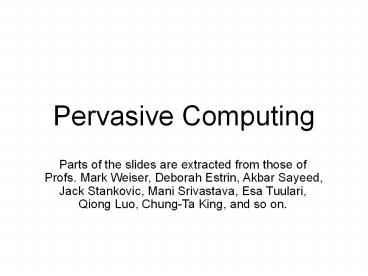Pervasive Computing PowerPoint PPT Presentation
Title: Pervasive Computing
1
Pervasive Computing
- Parts of the slides are extracted from those of
Profs. Mark Weiser, Deborah Estrin, Akbar Sayeed,
Jack Stankovic, Mani Srivastava, Esa Tuulari,
Qiong Luo, Chung-Ta King, and so on.
2
The Trends in Computing Technology
- 1970s
- 1990s
- Late 1990s
- Now and Tomorrow ?
3
Pervasive Computing Era
4
Computing Evolution
5
Ubiquitous Computing
- Mark Weiser, Xerox PARC 1988
- Ubiquitous computing enhances computer use by
making many computers available throughout the
physical environment, but making them effectively
invisible to the user.
Source Weiser, 1993a
6
Pervasive (Ubiquitous) Computing Vision
- In the 21st century the technology revolution
will move into the everyday, the small and the
invisible - The most profound technologies are those that
disappear. They weave themselves into the fabrics
of everyday life until they are indistinguishable
from it. - Mark Weiser (1952 1999), XEROX PARC
- Small, cheap, mobile processors and sensors
- in almost all everyday objects
- on your body (wearable computing)
- embedded in environment (ambient intelligence)
7
Related Topics
- Several terms that share a common vision
- Pervasive Computing
- Sentient computing
- Ubiquitous Computing
- Ambient Intelligence
- Wearable Computing
- Context Awareness
- ...
8
What is Ubiquitous Computing?
- Ubiquitous computing (ubicomp) integrates
computation into the environment, rather than
having computers which are distinct objects. - The idea of ubicomp enable people to interact
with information-processing devices more
naturally and casually, and in ways that suit
whatever location or context they find themselves
in. - from Wiki
9
Goals of Pervasive (Ubiquitous) Computing
- Ultimate goal
- Invisible technology
- Integration of virtual and physical worlds
- Throughout desks, rooms, buildings, and life
- Take the data out of environment, leaving behind
just an enhanced ability to act
10
Pervasive Computing Phase I
- Phase I
- Smart, ubiquitous I/O devices tabs, pads, and
boards - Hundreds of computers per person, but casual,
low-intensity use - Many, many displays audio, visual,
environmental - Wireless networks
- Location-based, context-aware services
- Using a computer should be as refreshing as a
walk in the woods
11
Smart Objects
- Real world objects are enriched with information
processing capabilities - Embedded processors
- in everyday objects
- small, cheap, lightweight
- Communication capability
- wired or wireless
- spontaneous networking and interaction
- Sensors and actuators
12
Smart Objects (cont.)
- Can remember pertinent events
- They have a memory
- Show context-sensitive behavior
- They may have sensors
- Location/situation/contextawareness
- Are responsive/proactive
- Communicate with environment
- Networked with other smart objects
13
Smart Objects (cont.)
14
Pervasive Computing Enablers
- Moores Law of IC Technologies
- Communication Technologies
- Material Technologies
- Sensors/Actuators
15
Moores Law
- Computing power (or number of transistors in an
integrated circuit) doubles every 18 months
16
Moores Law
1965
- Computing power (or number of transistors in an
integrated circuit) doubles every 18 months
17
Generalized Moores Law
- Most important technology parameters double every
13 years - computation cycles
- memory, magnetic disks
- bandwidth
- Consequence
- scaling down
Problems increasing cost energy
18
2nd Enabler Communication
- Bandwidth of single fibers 10 Gb/s
- 2002 20 Tb/s with wavelength multiplex
- Powerline
- coffee maker automatically connected to the
Internet - Wireless
- mobile phone GSM, GPRS, 3G
- wireless LAN (gt 10 Mb/s)
- PAN (Bluetooth), BAN
19
Body Area Networks
- Very low current (some nA), some kb/s through the
human body - Possible applications
- Car recognize driver
- Pay when touchingthe door of a bus
- Phone configures itselfwhen it is touched
20
Spontaneous Networking
- Objects in an open, distributed, dynamic world
find each other and form a transitory community - Devices recognize that they belong together
21
3rd Enabler New Materials
- Important whole eras named after materials
- e.g., Stone Age, Iron Age, Pottery Age,
etc. - Recent semiconductors, fibers
- information and communication technologies
- Organic semiconductors
- change the external appearance of computers
- Plastic laser
- Flexible displays,
22
Interactive Map
- Foldable and rollable
You are here!
23
Smart Clothing
- Conductive textiles and inks
- print electrically active patterns directly onto
fabrics - Sensors based on fabric
- e.g., monitor pulse, blood pressure, body
temperature - Invisible collar microphones
- Kidswear
- game console on the sleeve?
- integrated GPS-driven locators?
- integrated small cameras (to keep the parents
calm)?
24
Smart Glasses
- By 2009, computers will disappear. Visual
information will be written directly onto
ourretinas by devices inour eyeglasses
andcontact lenses-- Raymond Kurzweil
25
4th Enabler Sensors/Actuators
- Miniaturized cameras, microphones,...
- Fingerprint sensor
- Radio sensors
- RFID
- Infrared
- Location sensors
- e.g., GPS
- ...
26
Example Radio Sensors
- No external power supply
- energy from theactuation process
- piezoelectric andpyroelectric materialstransform
changes inpressure or temperatureinto energy - RF signal is transmitted via an antenna (20 m
distance) - Applications temperature surveillance, remote
control (e.g., wireless light switch),...
27
RFIDs (Smart Labels)
- Identify objects from distance
- small IC with RF-transponder
- Wireless energy supply
- 1m
- magnetic field (induction)
- ROM or EEPROM (writeable)
- 100 Byte
- Cost 0.1 ... 1
- consumable and disposable
- Flexible tags
- laminated with paper
28
Outline of the Course (1)
- Introduction to Pervasive Computing
- Wireless Communications
- Mobile Ad Hoc Networks (MANETs)
- Wireless Sensor Networks (WSNs)
- Media Access Control (MAC) Protocols
- Wireless Sensor Network Deployment
- Data-Centric Routing for WSNs
29
Outline of the Course (2)
- Congestion Control and Avoidance for WSNs
- WSN Data Aggregation
- Localization
- Geographical Routing
- Location Service
- Event Detection
- Target Tracking
- RFID
- RFID anti-collision algorithms
- Ubiquitous Guiding System
30
- QA

